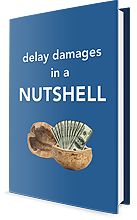Delay Damages: Calculating Extended Field Office Overhead Costs
Perhaps the most common delay-related cost alleged in claims, and as part of time extension requests, is one that focuses on extended field office overhead and job supervision costs. As we know, construction projects require field office labor and equipment to be maintained throughout the duration of the project, but those costs are not necessarily chargeable to a particular item of work. These costs are what we call “time-dependent” costs, and include things such as job site trailers, sanitary facilities, office equipment, security resources, phone/electrical/water services, and salaried job supervision personnel such as project managers, project engineers, superintendents, and administrative staff.
Naturally, when a project is delayed, these time-dependent costs will be required to support the project for a longer time period, and will cost a contractor more than what was anticipated in its bid. The question is – what is the proper way to calculate and account for these increased costs?
Often, both owners and contractors will take the simplest, albeit the least persuasive, way to calculate their field office overhead costs by establishing one field office overhead daily rate for the life of the project. This often results in an amount that is either more or less than the proper amount that should apply for the period in which the delay was experienced.
A contractor’s daily rate for field office labor and equipment is generally not linear over the life of the project. Rather, these costs typically follow a curve as they build up during the initial phases of the project, level off at their highest once the project is in full swing, and then gradually decrease as the project work nears the end. When the project finishes late as a result of delays by the owner, contractors often make the mistake of requesting the field office costs incurred after the planned completion date, seriously undervaluing the costs that were incurred.
Therefore, the proper, and more persuasive way to calculate this type of damage, is by using a daily rate that is more in line with the actual expenditures at the time the delay was experienced. To determine the rate to apply to a particular delay, it is appropriate to break the project into phases and develop a daily rate for each phase. Typically, three phases are investigated: the start-up phase, the construction phase, and the completion phase, although more may be applicable depending upon the way the field overhead costs were incurred. The beginning and ending points of these phases should coincide with the trend of expenditures discussed earlier. Determining these points will require judgment – the objective being to arrive at a daily rate that best corresponds to the timing of the delay.
For example, if there is a delay at the beginning of the project, the extended field office costs incurred as a result of this delay will be at the start-up rate, which may be less than when the project is in full swing. Similarly, if the delay occurs in the middle of the construction period, when the maximum resources are being applied, the rate will be greater than that occurring during the start-up or completion phases of the project. This will result in a greater than average rate developed for the entire project. As would be expected, the daily rate of field overhead costs would be higher in the construction phase than they would be in the start-up and completion phases.
Once you have broken your project’s field overhead cost curve into the appropriate phases, and have identified in which phase the delay occurred, you can simply use the daily rate associated with that phase for this calculation. Not only is this method more persuasive to the party evaluating your request, but it also more accurately calculates the actual costs you incurred for field office overhead damages as a result of the delay.
For more on this or any other topic, please call me at 215-814-6400 or email me at mark.nagata@traunerconsulting.com.

